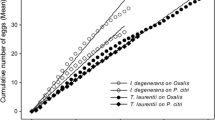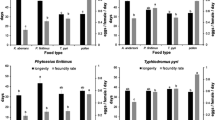Abstract
The predacious mite, Cydnodromella negevi (Swirski & Amitai) completed life cycle when fed on the tetranychid mites Eutetranychus orientalis (Klein), Tetranychus urticae Koch and pollen grains of Ricinus communis (L.) as an alternative food substance in the laboratory. The duration of the immature stages and adult stage were determined. Immature stages of C. negevi consumed in total an average of 27 E. orientalis and 34 T. urticae, whereas each day throughout her life, the adult female consumed an average of 11 of E. orientalis and T. urticae. While feeding on these prey, C. negevi laid 13 and 1.0 eggs per day. The number of eggs deposited per day increased (33 eggs/female/day) when fed on eriophyid mites. Females neither fed nor reproduced on liquid nutrients.
Résumé
L’acarien prédateur Cydnodromella negevi (Swirski et Amitai) a achevé son cycle de vie quand il s’est nourri des acariens tetranychides Eutetranychus orientalis (Klein), Tetranychus urticae Koch et de grains de pollen de Ricinus communis (L.) comme substance alimentaire de remplacement au labratoire. Les dureés des stades non murs et adulte ont été déterminées. Les stades pré-adultes consomment au total en moyenne 27 E. orientalis et 34 T. urticae par jour pendant toute leur existence, la famella adulte une moyenne de 11 E. orientalis et T. urticae. Elle pond 1.3 et 1.0 oeufs par jour. Le nombre d’oeufs déposés par jour a augmenté (3.3 Oeufs/female/jour) lorsqu’il s’alimentait sur de acariens eriophyides. Les femelles ne s’alimentaient ni ne se reproduisaient sur liquide nutritif.
Similar content being viewed by others
References
Abou-Awad B.A. (1983) Amblyseius gossipi (Acarina: Phytoseiidae) as a predator of the tomato erineum mite, Eriophyes lycopersici (Acari: Eriophyidae). Entomophaga 28, 363–366.
Abou-Awad B.A. and ElBanhawy E.M. (1986) Biological studies of Amblyseius olivi, a new predator of eriophyid mites infesting olive trees in Egypt (Acari: Phytoseiidae). Entomophaga 31, 99–103.
Amano H. and Chant D.A. (1978) Some factors affecting reproduction and sex ratios in two species of predacious mites, Phytoseiulus persimilis Athias-Henriot and Amblyseius andersoni (Chant) (Acarina: Phytoseiidae). Can. J. Zool. 56, 1593–1607.
Burrel R.W. and McCormik W.J. (1964) Typhlodromus and Amblyseius (Acarina: Phytoseiidae) as predators on orchard mites. Ann. Entomol. Soc. Am. 57, 483–487.
Chant D.A. (1959) Phytoseiid mites (Acarina: Phytoseiidae). Part 1. Bionomics of seven species in southeastern England. Part 11. A taxonomic review of the family Phytoseiidae, with descriptions of 38 new species. Can. Entomol. 91, 166.
Croft B.A. and Jorgensen C.D. (1969) Life history of Typhlodromus mcgregori (Acarina: Phytoseiidae). Ann. Entomol. Soc. Am. 62, 1261–1267.
Dosse G. (1961) Uber die Beudeutung der Pollennahrung fur Typhlodromus pyri Scheuten (tiliae Oud.) (Acarina: Phytoseiidae). Entomol. Exp. Appl. 4, 101–195.
Duncan D.B. (1955) Multiple range and multiple F test. Biometrics 11, 1–42.
Easterbrook M.A. (1982) Effect of pesticides on apple rust mite, Aculus schlechtendali. Bull. Org. Int. Lutte Biol. Contre les animaux et les plants nuisibles/Section regionale ouest palearctique 5, 51–53.
ElBadry E.A. and ElBanhawy E.M. (1968a) The effect of nonprey food, mainly pollen, on the development, survival and fecundity of Amblyseius gossipi (Acarina: Phytoseiidae). Entomol. Exp. Appl. 11, 269–272.
ElBadry E.A. and ElBanhawy E.M. (1968b) The effect of pollen feeding on the predatory efficiency of Amblyseius gossipi (Acarina: Phytoseiidae). Entomol. Exp. Appl. 11, 273–276.
ElBanhawy E.M. (1974) Life history studies on the predatory mite Phytoseius finitimus Ribaga (Acarina: Phytoseiidae). Rev. Bras. Biol. 34, 437–442.
ElBanhawy E.M. (1975) Biology and feeding behaviour of the predatory mite, Amblyseius brazili (Mesostigmata:Phytoseiidae). Entomophaga 20, 353–360.
ElBanhawy E.M. and Abou-Awad B.A. (1984-1985) Comparison between generations and reproduction of Amblyseius gossipi, maintained on natural and artificial diets. Bull. Soc. entomol. Egypte 65, 223–226.
Hoy M.A. and Smilanick J.M. (1979) A sex pheromone by immature and adult females of the predatory mite, Metaseiulus occidentalis (Nesbitt). Entomol. Exp. Appl. 26, 97–104.
Huffaker C.B. (1958) Experimental studies on predation: Dispersion factor and predator-prey oscillations. Hilgardia 27, 343–383.
Huffaker C.B. and Kennett C.E. (1956) Experimental studies on predation: Predation and cyclamen mite populations on strawberries in California. Hilgardia 191–222.
Huffaker C.B., Van de Vrie M. and McMurtry J.A. (1970) Ecology of tetranychid mites and their natural enemies: A review. II. Tetranychid population and their possible control by predators: An evaluation. Hilgardia 40, 391–458.
Kennett C.E. and Hamai J. (1980) Oviposition and development in predacious mite fed artificial and natural diets (Acari: Phytoseiidae). Entomol. exp. appl. 28, 116–122.
Kennett C.E., Flaherty D.L. and Hoffmann R.W. (1979) Effect of wind-borne pollens on the population dynamics of Amblyseius hibisci (Acarina: Phytoseiidae). Entomophaga 24, 83–98.
Kinsley C.B. and Swift F.C. (1971) Biological studies of Amblyseius umbraticus (Acarina: Phytoseiidae). Ann. Entomol. Soc. Am. 64, 813–822.
McMurtry J.A. and Johnson H.G. (1965) Some factors influencing the abundance of the predacious mite Amblyseius hibisci in Southern California. Ann. Entomol. Soc. Am. 58, 49–56.
McMurtry J.A. and Scriven G.T. (1964) Biology of the predacious mites Typhlodromus rickeri (Acarina: Phytoseiidae). Ann. Entomol. Soc. Am. 57, 362–367.
McMurtry J.A. and Scriven G.T. (1966) Effect of artificial foods on reproduction and development of four species of phytoseiid mites. Ann. Entomol. Soc. Am. 59, 267–369.
Nasr A.K. and ElBanhawy E.M. (1984) Effect of liquid nutrients on the development and reproduction of the predacious mite Amblyseius gossipi (Mesostigmata: Phytoseiidae). Int. J. Acarol. 10, 235–237.
Overmeer W.P.J. (1981) Notes on breeding phytoseiid mites from orchards (Acarina: Phytoseiidae) in the laboratory. Meded. Fac. Landbouwwet. Rijksuniv. Gent. 46, 503–509.
Putman W.L. (1962) Life history and behaviour of the predacious mite Typhlodromus (T.) caudiglans Snuster (Acarina: Phytoseiidae) in Ontario, with notes on the prey of related species. Can. Entomol. 94, 163–177.
Ragusa S. and Swirskii E. (1977) Feeding habits, post embryonic and adult survival, mating, virility and fecundity of the predacious mite Amblyseius swirskii (Acarina:Phytoseiidae) on some occids and mealy bugs. Entomophaga 22, 383–392.
Rasmy A.H. and ElBanhawy E.M. (1974) The phytoseiid mite Phytoseius plumifer as a predator of the eriophyid mite Aceria ficus (Acarina: Phytoseiidae). Entomophaga 19, 427–430.
Rasmy A.H. and ElBanhawy E.M. (1975) Biology and predatory efficiency of two phytoseiid mites as affected by long-term pollen feeding. Entomophaga 20, 93–95.
Saito Y. and Mori H. (1975) The effects of pollen as an alternative food for three species of phytoseiid mites (Acari: Phytoseiidae). Mem. Fac. Agric., Hokkaido Univ. 9, 236–246.
Sabelis M.W. (1985) Reproduction. In Spider Mites, Their biology, Natural Enemies and Control. World Crop Pests (Edited by W. Helle and Sabelis M.W), Vol IB pp. 73–81. Elsevier, Amsterdam.
Schulten G.G.M. (1985) Mating. In Spider Mites, Their Biology, Natural Enemies, and Control. World Crop Pests (Edited by W. Helle and Sabelis M.W.) Vol. IB. pp. 55–65. Elsevier, Amsterdam.
Shehata K.K. and Weismann L. (1972) Rearing the predacious mite Phytoseiulus per similis Athias-Henrioton artificial diet(Acarina: Phytoseiidae). Biologia Bratislava 27, 609–615.
Tanigoshi L.K. (1982) Advances in knowledge of the biology of the Phy toseiidae. In Recent Advances in Knowledge of the Phytoseiidae. (Edited by Hoy M.A.). pp. 1–22. Division of Agricultural Science, University of California, Publication 3248.
Zaher M.A., Wafa A.K. and Shehata K.K. (1969) Life history of the predatory mite Phytoseius plumifer and the effect of nutrition on its biology (Acarina: Phytoseiidae). Entomol. exp. appl. 12, 383–388.
Author information
Authors and Affiliations
Rights and permissions
About this article
Cite this article
Abou-Awad, B.A., Nasr, A.K., Gomaa, E.A. et al. Life History of the Predatory Mite, Cydnodromella Negevi and the Effect of Nutrition on Its Biology (Acari: Phytoseiidae). Int J Trop Insect Sci 10, 617–623 (1989). https://doi.org/10.1017/S1742758400021743
Received:
Revised:
Published:
Issue Date:
DOI: https://doi.org/10.1017/S1742758400021743




